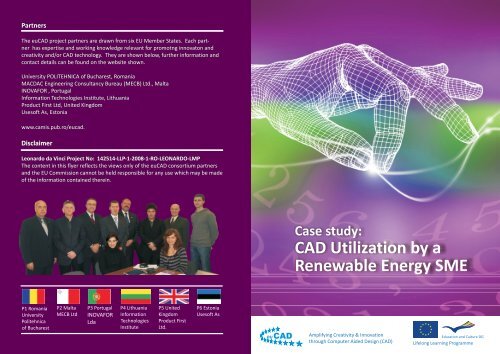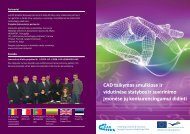Case study: CAD Utilization by a Renewable Energy SME
Case study: CAD Utilization by a Renewable Energy SME
Case study: CAD Utilization by a Renewable Energy SME
You also want an ePaper? Increase the reach of your titles
YUMPU automatically turns print PDFs into web optimized ePapers that Google loves.
Partners<br />
The eu<strong>CAD</strong> project partners are drawn from six EU Member States. Each part-<br />
ner has expertise and working knowledge relevant for promotng innovaton and<br />
creativity and/or <strong>CAD</strong> technology. They are shown below, further information and<br />
contact details can be found on the website shown.<br />
University POLITEHNICA of Bucharest, Romania<br />
MACDAC Engineering Consultancy Bureau (MECB) Ltd., Malta<br />
INOVAFOR , Portugal<br />
Information Technologies Institute, Lithuania<br />
Product First Ltd, United Kingdom<br />
Usesoft As, Estonia<br />
www.camis.pub.ro/eucad.<br />
Disclaimer<br />
Leonardo da Vinci Project No: 142514-LLP-1-2008-1-RO-LEONARDO-LMP<br />
The content in this flyer reflects the views only of the eu<strong>CAD</strong> consortium partners<br />
and the EU Commission cannot be held responsible for any use which may be made<br />
of the information contained therein.<br />
<strong>Case</strong> <strong>study</strong>:<br />
<strong>CAD</strong> <strong>Utilization</strong> <strong>by</strong> a<br />
<strong>Renewable</strong> <strong>Energy</strong> <strong>SME</strong><br />
P1 Romania<br />
University<br />
Politehnica<br />
of Bucharest<br />
P2 Malta<br />
MECB Ltd<br />
P3 Portugal<br />
INOVAFOR<br />
Lda<br />
P4 Lithuania<br />
Information<br />
Technologies<br />
Institute<br />
P5 United<br />
Kingdom<br />
Product First<br />
Ltd.<br />
P6 Estonia<br />
Usesoft As<br />
eu<strong>CAD</strong><br />
Amplifying Creativity & Innovation<br />
through Computer Aided Design (<strong>CAD</strong>)<br />
Education and Culture DG<br />
Lifelong Learning Programme
EXPLOITING <strong>CAD</strong> TECHNOLOGY FOR<br />
RENEWABLE ENERGY SYSTEM DESIGN<br />
<strong>SME</strong>/company<br />
Gozo Enterprises Limited a micro-<strong>SME</strong> based in Malta,<br />
have developed and built a prime-mover machine prototype<br />
for<br />
an innovative water pump used for the generation of<br />
electricity, which makes use of a new type of <strong>Renewable</strong> <strong>Energy</strong><br />
Source (RES) with huge upward potential of economic and<br />
ecological benefits. This prime-mover machine<br />
is called the<br />
SPITERI WATER PUMP (SWP).<br />
The concept of this technical<br />
system<br />
exploits the repeated up thrust of a buoyant body<br />
submerged in water and transfers this energy into pumping<br />
water to higher elevations (to an artificial waterfall) such that<br />
its potential energy could then be transferred to energy<br />
producing turbines. By inducing up thrust twice and gravity<br />
once, the SWP is able to pump water upwards creating<br />
an Artificial Waterfall.<br />
From this waterfall, turbines can<br />
be used to generate electricity around the clock, at any<br />
site in the world where there are no natural waterfalls<br />
or rivers and this at a very low cost, which is better<br />
than wind power.<br />
There is a physical prototype proving<br />
this invention and an WIPO patent Application. In 2007,<br />
the solution was declared the National <strong>Energy</strong> Globe Overall<br />
Winner for Malta. Full details http://www.joespiterisargent.com/<br />
Challenge<br />
For many micro-<strong>SME</strong>s, securing venture capital funding to commercialize<br />
solution concepts conceived is an important yet challenging stage.<br />
Business Angels and Venture Capitalists are <strong>by</strong> default interested in<br />
investing in high-growth sectors. They thus want to also feel comfortable<br />
that any technology they are investing in is sound and one which makes<br />
practical and business sense. Entrepeneurs such as Engineer Joe Spiteri,<br />
founder of Gozo Enterprises, approaching busy venture capitalists for<br />
investing in their technical solutions thus have a challenge: they need to<br />
explain the basic working principles of their solution and make a business<br />
case in a relatively short time. As one knows, a picture is worth a thousand<br />
words, yet a good video animation is worth much more as it can help<br />
venture capitalists virtually see a solution to help them understand how<br />
it operates and how it can be practically applied from<br />
a commercial<br />
perspective.<br />
This is indeed a typical <strong>CAD</strong> application embarked upon <strong>by</strong><br />
Gozo Enterprises. Over time, they were realizing that it was difficult for<br />
them to present paper-based technical drawings and technical user<br />
manuals to venture capitalists. They needed a faster yet more understandable<br />
way of how they can communicate to non-technical people,<br />
the concept of their solutions and to thus make a case for investment.<br />
Solution<br />
To solve the above problem, Gozo Enterprises decided to develop a 3D<br />
animated <strong>CAD</strong> model of their renewable energy solution. After meeting<br />
with their <strong>CAD</strong> sub-contractors MECB Ltd, explaining their vision of what<br />
‘story’ they intended to disclose to their viewers, they embarked upon a<br />
series of meetings during which different parts of their technical system<br />
were constructed and modeled in 3D <strong>CAD</strong>. This exercise in itself, allowed<br />
certain details to be checked, that would otherwise have not been apparent.<br />
After several hours invested in building up the different parts, using <strong>CAD</strong><br />
they virtually assembled the parts into different sub-assemblies.<br />
Following<br />
that, the different sub- assemblies were geometrically related and<br />
constrained with respect to each other to form a complete technical<br />
system. At this stage, the static 3D <strong>CAD</strong> model was complete,<br />
meaning that movements to now create the necessary<br />
animated steps of the agreed ‘story board’ could be developed.<br />
Benefits of Using <strong>CAD</strong> Technology<br />
Benefits of Using <strong>CAD</strong> Technology<br />
“Through <strong>CAD</strong>, the different parts were given different colours, textures and<br />
defined different degrees of movement. <strong>CAD</strong> also allowed different<br />
parameters to be rapidly explored eg. what colours best to use, which parts<br />
of the system could be best shown<br />
transparent to portray how the system<br />
works internally etc.<br />
In addition, the virtual 3D <strong>CAD</strong> model also allowed<br />
experimentation with how the solution can be seen<br />
operating in practice.<br />
Thus, <strong>by</strong> placing virtual lights to create shadows and other virtual environmental<br />
objects (e.g. trees, buildings), a possible, real application scene started taking<br />
shape.<br />
Also, <strong>CAD</strong> allowed us to rapidly explore different viewing positions.<br />
Whilst that Computer Aided Design (<strong>CAD</strong>) technology is definitely<br />
a good<br />
tool to help with the externalization and exploration of technical concepts,<br />
in our case we found the tool also useful also for marketing. This is because<br />
<strong>CAD</strong> technology allowed us to portray not only how our solution concept<br />
operates, but we could also present a typical practical scenario of how when<br />
fully developed, it can be exploited in the real world. In the early days, I had<br />
painfully made a manually generated animation which was very laborious<br />
to achieve. Having seen how such a video animation can be now performed<br />
via 3D <strong>CAD</strong> technology, I can truly state that <strong>CAD</strong> technology is really worth<br />
learning and exploiting as it provides a wide range of opportunities.<br />
With<br />
today’s applications, <strong>CAD</strong> models can be rendered and printed, converted into<br />
video animations, used for stress analysis and if need be, used to generate<br />
physical models using rapid prototyping (RP) technology. Clearly, the sky is<br />
becoming the limit as to what can be achieved via <strong>CAD</strong> technology. And very<br />
important too is that this technology is now within reach even to micro <strong>SME</strong>s.”<br />
Engineer Joe Spiteri Sargent



